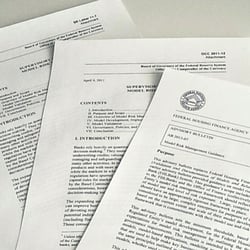New Supervisory Guidance for Model Governance
March 31, 2016 •Anthony Curcio

 In our last post, I considered how the Great Recession affected the culture of quantitative financial modeling. The downturn reminded us that quantitative models—and their brilliant designers—require oversight just like the rest of us. Governance is not a conspiracy by auditors and circular writers to make modelers miserable. Rather, good governance greatly increases the accuracy, reliability, and usability of a model. It also protects modelers from being left holding the bag if the model fails.
In our last post, I considered how the Great Recession affected the culture of quantitative financial modeling. The downturn reminded us that quantitative models—and their brilliant designers—require oversight just like the rest of us. Governance is not a conspiracy by auditors and circular writers to make modelers miserable. Rather, good governance greatly increases the accuracy, reliability, and usability of a model. It also protects modelers from being left holding the bag if the model fails.
Federal risk managers turn to guidance designed for Government-sponsored enterprises and private sector financial institutions
Neither the Office of Management and Budget (OMB) nor the Financial Accounting Standards Board (FASB) have issued guidelines specific to model governance for federal risk managers. Model governance is a distinct discipline that, while it supports other goals, mitigates risks that are distinct from fair statements and robust controls.
This means that those interested in developing a sustainable and quality model governance program within the Federal space must look to guidance issued by regulators of private financial institutions and government-sponsored enterprises (GSEs).
Best Available Guidance on Model Governance
 In the wake of the financial crisis, the Office of the Comptroller of the Currency (OCC), Federal Reserve Board (FRB), and Federal Housing Finance Agency (FHFA) released new supervisory guidance. This new guidance, applied to regulated financial institutions and FHFA’s “regulated entities,” directly addressed model governance. As of 2016, these two documents serve as the best source of guidance on model governance for federal risk managers:
In the wake of the financial crisis, the Office of the Comptroller of the Currency (OCC), Federal Reserve Board (FRB), and Federal Housing Finance Agency (FHFA) released new supervisory guidance. This new guidance, applied to regulated financial institutions and FHFA’s “regulated entities,” directly addressed model governance. As of 2016, these two documents serve as the best source of guidance on model governance for federal risk managers:
- Federal Reserve Board SR 11-7 and Office of the Comptroller of the Currency (OCC) Bulletin 2011-12 describe the elements of a sound program for effective management of risks that arise when using quantitative models in decision making. It requires model risk to be managed from time of model development, including need for risk management by model developers and users, internal or external independent model validation teams, and internal audit and top management review.
- Federal Housing Finance Agency (FHFA) Advisory Bulletin (AB) 2013-07 sets the minimum thresholds for model risk management by outlining the necessary framework of baseline control and governance requirements. This bulletin uses a risk-based approach to models, model-based applications, modeling processes, and significant end user computing tools that are used to help make key management decisions.
How Federal Risk Managers can Implement This Guidance
These supervisory documents provide federal risk managers with comprehensive guidance on effective model risk management. The application of the guidance should be commensurate with the program’s mission and the complexity and materiality of its model use. In other words, managers of larger, more complex, and material models should apply these standards more rigorously, while managers of smaller, less complex, and material models should consider a more relaxed application of the concepts.
In the next federal credit post, we will dive into the details of these two supervisory documents and discuss how to apply them to federal risk management. In the meantime, check out Summit's past posts about federal credit.
Get Updates
Featured Articles
Categories
- affordable housing (12)
- agile (3)
- AI (4)
- budget (3)
- change management (1)
- climate resilience (5)
- cloud computing (2)
- company announcements (15)
- consumer protection (3)
- COVID-19 (7)
- data analytics (82)
- data science (1)
- executive branch (4)
- fair lending (13)
- federal credit (33)
- federal finance (4)
- federal loans (4)
- federal register (2)
- financial institutions (1)
- Form 5500 (5)
- grants (1)
- healthcare (17)
- impact investing (12)
- infrastructure (13)
- LIBOR (4)
- litigation (8)
- machine learning (2)
- mechanical turk (3)
- mission-oriented finance (7)
- modeling (9)
- mortgage finance (10)
- office culture (26)
- opioid crisis (5)
- Opportunity Finance Network (4)
- opportunity zones (12)
- partnership (15)
- pay equity (5)
- predictive analytics (15)
- press coverage (3)
- program and business modernization (7)
- program evaluation (29)
- racial and social justice (8)
- real estate (2)
- risk management (10)
- rural communities (9)
- series - loan monitoring and AI (4)
- strength in numbers series (9)
- summer interns (7)
- taxes (7)
- thought leadership (1)
- white paper (15)



